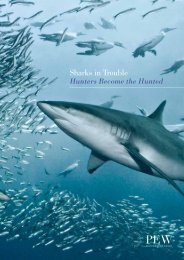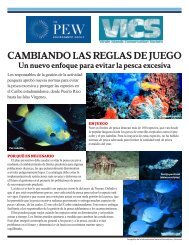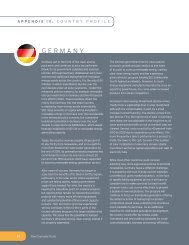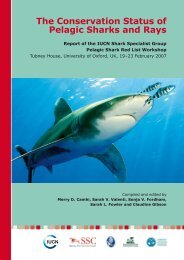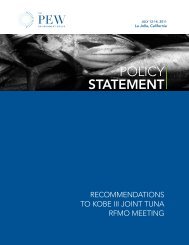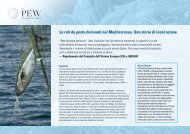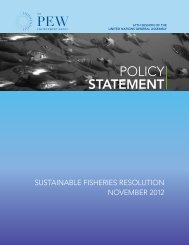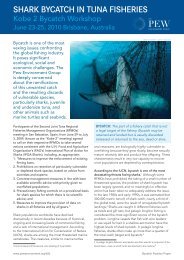The Marine Environment of the Pitcairn Islands - Pew Environment ...
The Marine Environment of the Pitcairn Islands - Pew Environment ...
The Marine Environment of the Pitcairn Islands - Pew Environment ...
You also want an ePaper? Increase the reach of your titles
YUMPU automatically turns print PDFs into web optimized ePapers that Google loves.
3.3.1 Introduction<br />
Oeno consists <strong>of</strong> a central, low-lying island surrounded<br />
by a shallow lagoon and a fringing reef. In 1991 a sand<br />
spit extended from <strong>the</strong> nor<strong>the</strong>rn end <strong>of</strong> <strong>the</strong> main island,<br />
though this is known to have changed in shape over<br />
time as a result <strong>of</strong> water movements within <strong>the</strong> lagoon<br />
leading to sand accretion/erosion (Figure 10 and Plates<br />
40 & 41). Around 1990, <strong>Pitcairn</strong>ers planted a number <strong>of</strong><br />
young trees to help stabilise <strong>the</strong> sand spit. However, it can<br />
be seen in Plate 41 (taken in 2011) that <strong>the</strong> sand bar has<br />
been breached and a small sandy islet has been formed.<br />
<strong>The</strong> main island, covered by a mix <strong>of</strong> trees and o<strong>the</strong>r<br />
vegetation, is fringed by a narrow beach <strong>of</strong> sand with<br />
bedrock apparent on <strong>the</strong> north-west side <strong>of</strong> <strong>the</strong> island.<br />
3.3.2 Lagoon – habitats and species<br />
<strong>The</strong> shallow lagoon surrounding <strong>the</strong> central island is about<br />
3 m deep and has an undulating bottom <strong>of</strong> sand and coral<br />
rubble (60 percent), reef pavement (20 percent) and patch<br />
reefs (20 percent) (Irving, 1995). <strong>The</strong>se patch reefs have<br />
near-vertical sides, with some undercut at <strong>the</strong>ir bases to<br />
form small caves and overhangs. <strong>The</strong> most striking feature<br />
is <strong>the</strong> large number <strong>of</strong> giant clams Tridacna maxima<br />
(see Plate 45) embedded in <strong>the</strong>se reefs, at an estimated<br />
maximum density <strong>of</strong> 8–10/m 2 . Paulay (1989) reported<br />
that several Montipora species dominated <strong>the</strong> coral fauna<br />
within <strong>the</strong> lagoon, with Acropora humilis, Acropora secale,<br />
Pavona varians, Montastrea curta and Cyphastrea cf.<br />
serailia also being common. Pandolfi (1995) reported large<br />
stands <strong>of</strong> monospecific coral rubble within <strong>the</strong> lagoon,<br />
upon which smaller corals were growing. Various species<br />
<strong>of</strong> wrasse were <strong>the</strong> commonest fish seen in <strong>the</strong> lagoon in<br />
November 1991 (R.A. Irving, pers. obs.).<br />
3.3.3 Bathymetry and marine habitats<br />
Outside <strong>the</strong> margin <strong>of</strong> <strong>the</strong> fringing reef, <strong>the</strong> fore-reef<br />
slopes gradually into deeper water, steepening beyond <strong>the</strong><br />
30 m depth contour. <strong>The</strong> percentage <strong>of</strong> live coral cover on<br />
<strong>the</strong> fore-reef is greatest within <strong>the</strong> 11–20 m depth band<br />
(at a mean <strong>of</strong> 60 percent) and within <strong>the</strong> 21–30 m depth<br />
band (55 percent), decreasing to 10 percent cover within<br />
<strong>the</strong> 31–40 m depth band. <strong>The</strong> overall live coral cover<br />
recorded in 1991 was greater than that at Henderson but<br />
less than that at Ducie (Irving, 1995). In contrast to Ducie,<br />
large areas <strong>of</strong> sand were present, toge<strong>the</strong>r with extensive<br />
areas <strong>of</strong> coral rubble. A series <strong>of</strong> sand channels, up to<br />
3 m wide, were found to run perpendicular to <strong>the</strong> reef<br />
between 5–20 m depth.<br />
3.3.4 <strong>Marine</strong> species<br />
SPONGES<br />
Just four sponge species have been recorded from Oeno’s<br />
nearshore waters during a five-day visit to <strong>the</strong> island by<br />
Irving in 1991 (Irving, 1995): Ascaltis sp. (a lime-green<br />
sponge); Batzella sp. (an orange sponge); Cliona sp. aff.<br />
vastifica (a black sponge); and Spirastrella decumbens<br />
(a rust-brown sponge). <strong>The</strong> conservation status <strong>of</strong> <strong>the</strong>se<br />
species (as with most sponges) has yet to be assessed by<br />
<strong>the</strong> IUCN.<br />
CORALS, etc.<br />
A total <strong>of</strong> 17 species <strong>of</strong> scleractinian (stony) coral have<br />
been recorded from Oeno, which is a relatively low<br />
diversity and puts it on a par with <strong>Pitcairn</strong>’s coral fauna<br />
(15 species), but far fewer than ei<strong>the</strong>r Ducie’s (27 species)<br />
or Henderson’s (59 species). Within <strong>the</strong> IUCN Red List<br />
(2012), one species (Acropora acuminata) is listed as<br />
Vulnerable; four species (Montipora foveolata, Montipora<br />
incrassata, Acropora humilis and Acropora secale) as<br />
Near Threatened; and eight as being <strong>of</strong> Least Concern<br />
(Montipora grisea, Montipora tuberculosa, Acropora<br />
cy<strong>the</strong>rea, Psammocora haimeana, Pavona varians,<br />
Montastrea curta, Plesiastrea versipora and Leptastrea<br />
purpurea). <strong>The</strong> remaining four species are not considered<br />
to be <strong>of</strong> conservation concern.<br />
CRUSTACEANS<br />
Collections <strong>of</strong> crustaceans were made from Oeno by R.A.<br />
Irving and J. Jamieson in 1991. However, many <strong>of</strong> <strong>the</strong>se<br />
specimens have still to be identified to species level (<strong>the</strong>y<br />
currently reside at <strong>the</strong> Natural History Museum, London).<br />
Table 10 sets out <strong>the</strong> probable number <strong>of</strong> species within<br />
this collection which were collected from Oeno.<br />
O<strong>the</strong>r crustaceans that have been identified from Oeno<br />
are included in Appendix 5.<br />
Table 10. Specimens <strong>of</strong> Crustacea collected from<br />
Oeno by R.A. Irving and J. Jamieson in 1991; <strong>the</strong>se<br />
still have to be identified to species level.<br />
Taxon Probable no. <strong>of</strong> species<br />
Xanthidae 6<br />
Grapsidae 3<br />
Portunidae 2<br />
Calappidae 1<br />
Anomura (hermit crabs) 3<br />
Natantia (shrimp-like) 1<br />
Alphaeidae 1<br />
Cirrepedia: Thoracica 1<br />
Total probable<br />
no. <strong>of</strong> species: 18<br />
MOLLUSCS<br />
Approximately 255 species <strong>of</strong> marine molluscs have now<br />
been recorded from Oeno. During <strong>the</strong> present review a<br />
fur<strong>the</strong>r 15 species have been added to <strong>the</strong> figure <strong>of</strong> 240<br />
given by Preece (1995a). Collections <strong>of</strong> molluscs were<br />
made by Rehder in 1970/71 (Rehder, 1974; Rehder &<br />
Wilson, 1975 – making use <strong>of</strong> a dredge), Paulay in 1987<br />
(Paulay, 1989 – only from <strong>the</strong> lagoon), and Preece in 1991<br />
(Preece, 1995a – only from <strong>the</strong> lagoon and <strong>the</strong> sand spit).<br />
A new genus and species <strong>of</strong> a prosobranch gastropod <strong>of</strong><br />
<strong>the</strong> Family Liotininae (due to be described by J.H. McLean<br />
<strong>of</strong> Los Angeles) was found by Preece (1995a) during<br />
his visit to Oeno in 1991. Ano<strong>the</strong>r new species Rissoina<br />
schubelae, also found by Preece in 1991, is believed to be<br />
endemic to Oeno (Sleurs & Preece, 1994; Preece, 1995a).<br />
<strong>The</strong> s<strong>of</strong>t sediments present in <strong>the</strong> shallow lagoon are<br />
particularly favourable for bivalves, and <strong>of</strong> <strong>the</strong> four islands<br />
Oeno supports <strong>the</strong> largest number <strong>of</strong> bivalve species (45)<br />
(Preece, 1995a).<br />
STARFISH, SEA URCHINS AND SEA CUCUMBERS<br />
(Echinodermata)<br />
A total <strong>of</strong> 19 species <strong>of</strong> echinoderms have been recorded<br />
from Oeno to date, consisting <strong>of</strong> five sea urchins,<br />
one starfish, six brittlestars (five <strong>of</strong> which are from<br />
deeper water and were collected by dredge) and seven<br />
holothurians (Paulay, 1989; Devaney, 1974).<br />
REEF FISHES<br />
<strong>The</strong>re have been 165 species <strong>of</strong> reef fishes recorded from<br />
Oeno (Randall, 1999), which amounts to 46 percent <strong>of</strong> <strong>the</strong><br />
total number recorded from all four islands (352 species).<br />
Of <strong>the</strong> 165 species, 20 have been recorded from Oeno<br />
alone. Some <strong>of</strong> <strong>the</strong> species only recorded from Oeno are<br />
commented on below.<br />
l <strong>The</strong> black-saddled coral grouper Plectropomus laevis<br />
is found throughout <strong>the</strong> Indo-Pacific. Its Red List<br />
conservation status is Vulnerable because <strong>of</strong> its natural<br />
rarity, <strong>the</strong> heavy fishing pressure being experienced<br />
throughout its range (particularly <strong>the</strong> targeting <strong>of</strong><br />
juveniles), and because it has shown declines in<br />
abundance <strong>of</strong> at least 30 percent (mature individuals).<br />
This trend is expected to continue into <strong>the</strong> future<br />
(IUCN, 2012).<br />
l Two species <strong>of</strong> frogfish have been recorded from Oeno:<br />
<strong>the</strong> freckled frogfish Antennarius coccineus and <strong>the</strong><br />
tuberculated frogfish Antennarius tuberosus. Frogfishes<br />
are peculiarly shaped fish, <strong>of</strong>ten very well camouflaged,<br />
which stay motionless on <strong>the</strong> seabed and use a small<br />
lure to entice fish close to <strong>the</strong>ir mouths.<br />
l <strong>The</strong> rockmover wrasse Novaculichthys taeniourus is<br />
found throughout <strong>the</strong> Indo-Pacific. It feeds on a variety<br />
<strong>of</strong> small invertebrates by physically moving small rocks<br />
to expose <strong>the</strong>m.<br />
TURTLES<br />
No recorded data exist for turtles seen ei<strong>the</strong>r on <strong>the</strong><br />
fore-reef or within <strong>the</strong> lagoon at Oeno. It would not be<br />
surprising, however, to find turtles within <strong>the</strong> lagoon here,<br />
though we are not aware <strong>of</strong> any nesting taking place. In<br />
a Secretariat <strong>of</strong> <strong>the</strong> Pacific Community report dating from<br />
1987 it states that “…Oeno Island is a turtle nursery <strong>of</strong><br />
international interest”. This is clearly not substantiated by<br />
<strong>the</strong> evidence to date.<br />
SEABIRDS<br />
Being uninhabited, seldom visited and relatively<br />
ecologically undisturbed, Oeno hosts large breeding<br />
populations <strong>of</strong> seabirds and has an internationally<br />
significant wintering population <strong>of</strong> <strong>the</strong> bristle-thighed<br />
curlew Numenius tahitiensis. Note that <strong>the</strong> Pacific rat<br />
Rattus exulans was eradicated from <strong>the</strong> island in 1997<br />
(M. Brooke, pers. comm.). A summary <strong>of</strong> <strong>the</strong> island’s<br />
avian importance is given in Table 11.<br />
In <strong>the</strong> order <strong>of</strong> 12,500 pairs <strong>of</strong> Murphy’s petrel Pterodroma<br />
ultima (1991/92 estimates) may breed on Oeno in any one<br />
season. (Note that <strong>the</strong> breeding population may well have<br />
30 <strong>The</strong> <strong>Marine</strong> <strong>Environment</strong> <strong>of</strong> <strong>the</strong> <strong>Pitcairn</strong> <strong>Islands</strong>: Oeno<br />
<strong>The</strong> <strong>Marine</strong> <strong>Environment</strong> <strong>of</strong> <strong>the</strong> <strong>Pitcairn</strong> <strong>Islands</strong>: Oeno<br />
increased since <strong>the</strong> 1997 rat eradication). This is some way<br />
short <strong>of</strong> <strong>the</strong> 250,000 pairs on Ducie, but is still impressive<br />
none<strong>the</strong>less. <strong>The</strong> worldwide population <strong>of</strong> Murphy’s petrel<br />
is estimated at 800,000 to one million individuals, though<br />
apart from Oeno and Ducie it is only known to breed in<br />
French Polynesia (Birdlife International Factsheet, 2012).<br />
<strong>The</strong> species was only described in 1949 (Murphy, 1949).<br />
Although <strong>the</strong>re is now confirmation that breeding has<br />
taken place by Phoenix petrels Pterodroma alba on Oeno<br />
(H. Shirihai, pers. comm.), <strong>the</strong> number <strong>of</strong> breeding pairs is<br />
uncertain.<br />
In January 1990, Brooke (1995a) recorded a maximum <strong>of</strong><br />
100 bristle-thighed curlew Numenius tahitiensis individuals<br />
on Oeno (Plate 42). With a world population believed<br />
to be around 7,000 birds (BirdLife International, 2012),<br />
<strong>the</strong> population here is <strong>of</strong> international significance (> 1<br />
percent <strong>of</strong> world population).<br />
CETACEANS<br />
No recorded data on cetaceans are available for Oeno.<br />
However, it is likely that <strong>the</strong> humpback whales which are<br />
known to visit both <strong>Pitcairn</strong> and Henderson may well visit<br />
Oeno too from July to September.<br />
3.3.5 Nearshore fisheries<br />
Fishing pressure at Oeno is negligible and is only likely to<br />
be undertaken by <strong>Pitcairn</strong>ers during <strong>the</strong>ir annual holidays<br />
to <strong>the</strong> island. No written records are available to determine<br />
which species (and in what quantity) are taken, but it is<br />
likely to be a similar range <strong>of</strong> species to those caught<br />
at <strong>Pitcairn</strong>.<br />
Plate 42. Bristle-thighed curlew Numenius tahitiensis.<br />
(Photo: M. Brooke)<br />
31




